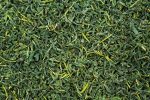
Wakame (ワカメ), Undaria pinnatifida is an important edible seaweed and a distinctive marine food. Japanese farmers of marine algae have been growing this seaweed since the Nara period. It is according to the Invasive Species Specialist Group, in the top 100 worst globally invasive species.
In various countries it has different names. It is known as wakame in Japan but in English, ‘sea mustard’. The Chinese call it qúndài cài (裙带菜) and in Korea it is known as miyeok (미역).
The French have cultivated the seaweed since 1983 where it is grown offshore in areas of Brittany.
From a food perspective, the fronds of wakame have a smooth, satin texture and a slightly sweet flavour. The leaves are often shredded or cut into small squares where they expand on cooking. They are commonly added to broths and soups. It is not unusual to find it in miso soup.
A popular Japanese seaweed salad, goma wakame is a popular side dish at American and European sushi restaurants. Literally translated, it means “sesame seaweed”, as sesame seeds are usually included in the recipe.
Health Benefits
Wakame seaweed contains a compound called fucoxanthin which has excited many researchers in the field of diabetes management and weight management. At the moment most of the studies on fucoxanthin concern mice but there are continuing studies in human to understand how the compound might help to reduce fat especially visceral fat.
Wakame contains significant levels of minerals salts such as iodine, sodium and calcium. It also contains the B vitamins, thiamine (vitamin B1) and niacin (vitamin B3).
Diabetes
One key study has shown that when wakame was fed to obese mice (Maeda et al., 2009), the indicators for conditions associated with diabetes such as hyperglycemia (high blood glucose levels), hyperinsulinemia, and hyperleptinemia were reduced. It is known that fucoxanthin found in wakame has a potent effect in reducing some of the more debilitating aspects associated with diabetes but more research is required to check these findings in humans.
References
Maeda, H.; Hosokawa, M.; Sashima, T.; Murakami-Funayama, K.; Miyashita, K. (2009) Anti-obesity and anti-diabetic effects of fucoxanthin on diet-induced obesity conditions in a murine model. Mol. Med. Rep. 2, pp. 897–902. https://www.ncbi.nlm.nih.gov/pubmed/21475918



Leave a Reply